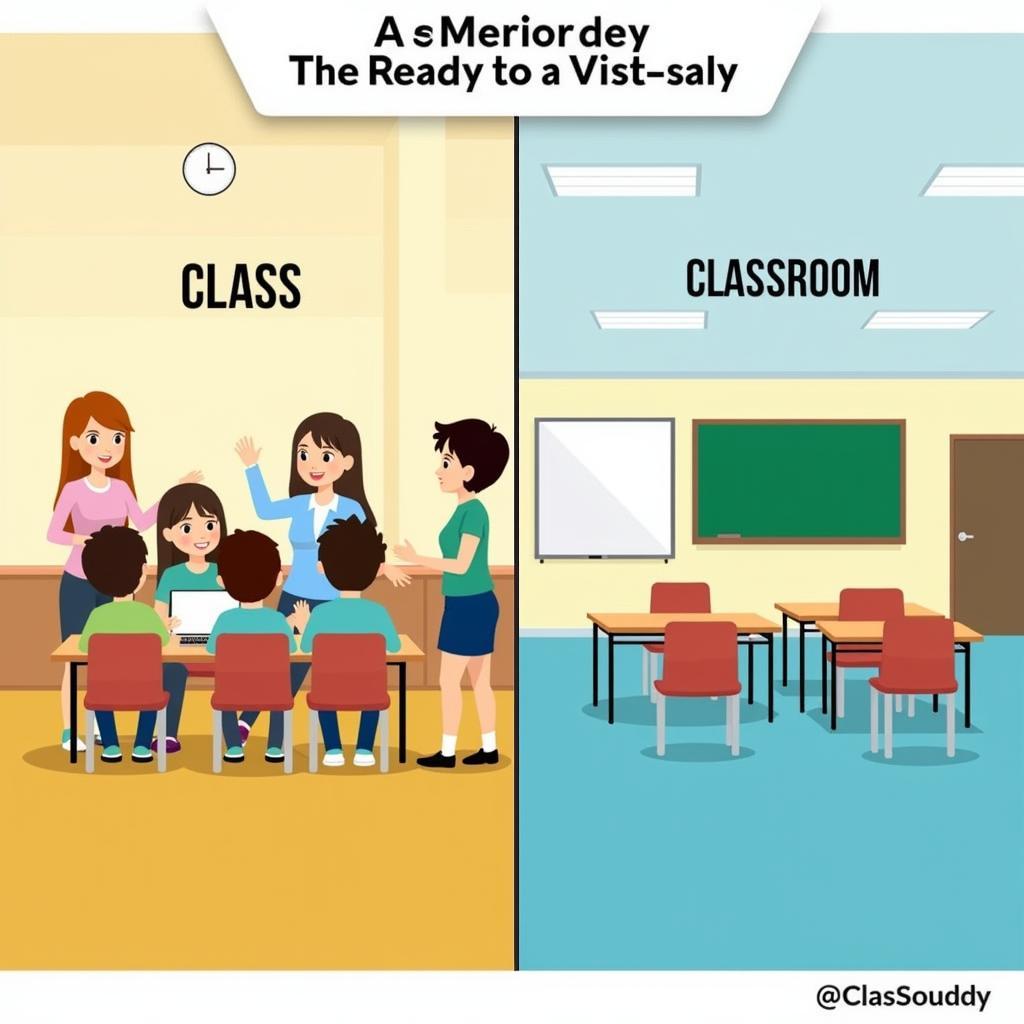Class and classroom are two terms often used interchangeably, especially when discussing education. However, they have distinct meanings. Understanding this difference is crucial for anyone involved in the educational process, whether you’re a student, teacher, or parent. Let’s dive into a detailed explanation of each term.  Sự khác biệt giữa lớp học và phòng học
Sự khác biệt giữa lớp học và phòng học
What is a Class?
A class refers to a group of students who are taught together. It represents the collective body of learners participating in a specific course or subject. Think of it as the community of learners. For example, “He is in the advanced English class.” Here, “class” refers to the group of students learning advanced English. This group remains the same regardless of where they meet. They can have class in a traditional classroom, online via Google Classroom (check out our comparison of Moodle vs Google Classroom), or even outdoors. The key defining feature is the shared learning experience.
Defining Characteristics of a Class
- Shared learning objective: Members of a class are united by their common goal of learning a specific subject or skill.
- Interaction and collaboration: Classes often involve interaction between students, fostering a sense of community and shared learning.
- Structure and guidance: A class typically follows a curriculum and is led by a teacher or instructor.
What is a Classroom?
A classroom, on the other hand, is the physical space where learning takes place. It’s the location, the room equipped with desks, chairs, a whiteboard, and other learning resources. For example, “The classroom is on the second floor.” Here, “classroom” refers to the specific room designated for learning. It can be used by different classes throughout the day.
Key Features of a Classroom
- Designated space: Classrooms are specifically designed for educational activities.
- Learning resources: They typically contain resources such as desks, chairs, whiteboards, projectors, and computers.
- Physical environment: The classroom environment can influence the learning experience, impacting factors like concentration and engagement.
Class vs Classroom: A Direct Comparison
The distinction between class and classroom can be summarized as follows: Class refers to the group of learners, while classroom refers to the physical space where learning occurs. Think of it this way: you can have a class without a classroom (like an online course), but you can’t have a classroom without a class (eventually, someone will use the space for learning). Just like the differences between school vs university are significant, so too are the differences between class and classroom.
What about online learning?
With the rise of online learning, the lines between class and classroom can become blurred. In these cases, the “classroom” might be a virtual space, a platform like Moodle or Google Classroom, where students interact and learn. The essence of the “classroom” remains: a dedicated environment for learning, even if it’s not a physical one.
When to Use “Class” and “Classroom”
Knowing when to use each term correctly is essential for clear communication. Use “class” when referring to the group of students or the learning activity itself. Use “classroom” when referring to the physical or virtual space where learning occurs.
-
Class examples: “My math class is challenging,” “She missed class today,” “He is the top student in his class.”
-
Classroom examples: “The classroom is too cold,” “Please clean the classroom after the lesson,” “The classroom is equipped with the latest technology.”
Conclusion: Clarifying the Distinction
Understanding the difference between class and classroom is essential for effective communication in educational contexts. While both terms relate to learning, they represent distinct aspects: the group of learners (class) and the physical or virtual space where learning takes place (classroom). By recognizing this distinction, we can communicate more precisely and avoid ambiguity. This is just as important as understanding the difference between homework vs assignment. Remember, clear communication is key to effective learning.
FAQ
- Can a class exist without a classroom?
- Can a classroom exist without a class?
- How has online learning changed the concept of a classroom?
- Why is it important to differentiate between class and classroom?
- What are some other words that can be used instead of “classroom”?
- What are some examples of different types of classes?
- How does the classroom environment affect learning?
Professor Nguyen Thanh Mai, a leading educator in Vietnam, emphasizes the importance of this distinction: “Understanding the difference between ‘class’ and ‘classroom’ is crucial for both educators and learners. It helps us be more precise in our language and avoid misunderstandings.” She adds, “While the physical classroom remains important, the concept of ‘class’ has evolved with online learning, demonstrating the adaptability of education.”
Dr. Le Van Tuan, a respected educational psychologist, notes: “The classroom environment plays a significant role in student learning. A well-designed classroom can promote engagement and focus, while a poorly designed one can hinder learning.” He continues, “The dynamic of the ‘class’ itself, the interaction between students and the instructor, is equally important for a positive learning experience.” This is especially true when exploring practical applications, much like the difference between evidence based practice vs practice based evidence.
For further assistance, consider reviewing the distinctions between frequently confused terms like I’m vs am. You might also find our articles on other educational topics helpful.
Khi cần hỗ trợ hãy liên hệ Số Điện Thoại: 02838172459, Email: truyenthongbongda@gmail.com Hoặc đến địa chỉ: 596 Đ. Hậu Giang, P.12, Quận 6, Hồ Chí Minh 70000, Việt Nam. Chúng tôi có đội ngũ chăm sóc khách hàng 24/7.